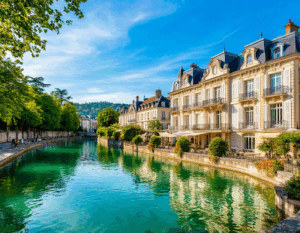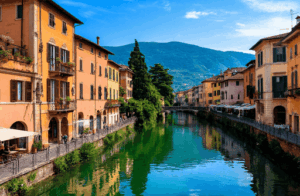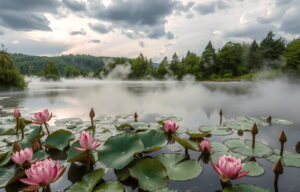Drinking Therapy
Drinking Therapy with Mineral Waters in Europe
Drinking therapy is the most popular method of spa treatment for gastrointestinal disorders. It is based on a course intake of mineral waters and is used for diseases of the stomach, pancreas, liver, as well as metabolic disorders and endocrine pathologies. Minerals obtained with the water act physiologically: they gently regulate gastric acidity, stimulate enzyme production, normalize liver and bile duct function, and maintain electrolyte balance.
The therapeutic effect directly depends on the type of water, its volume, temperature, and frequency of intake. Therefore, the parameters of a drinking therapy course should be determined by a physician, in accordance with the goals and the patient’s individual characteristics.
Drinking courses help relieve heartburn, heaviness, and abdominal pain, normalize bowel movements, and improve overall well-being already within the first week of treatment. For this reason, they are included in medical rehabilitation programs at leading European resorts.
The Value of Drinking Mineral Water
Mineral waters are formed deep underground, where for many years they pass through layers of rock, becoming enriched with bicarbonates, sulfates, chlorides, calcium, magnesium, and other microelements valuable for the human body. The deeper the source lies, the more stable its temperature and chemical composition.
Each region has its own unique “mineral profile.” For example, the waters of Karlovy Vary (Czech Republic) are rich in bicarbonates and sodium, while the springs of Vichy (France) contain silicic acid and rare trace elements. The composition directly determines the healing properties: some waters reduce gastric acidity, others stimulate intestinal function or support liver activity.
The most common types of mineral waters used for drinking therapy are:
- bicarbonate
- sulfate
- chloride-sodium
- siliceous
Types of Mineral Waters and Their Healing Properties
During natural filtration, water becomes enriched with salts, gases, and microelements. The concentration and ratio of these substances determine the conditions for which it will be particularly beneficial.
Below are the most common types of mineral waters beneficial for health.
Bicarbonate Waters
Bicarbonate waters contain sodium, calcium, or magnesium salts combined with bicarbonates. They gently reduce gastric acidity, decrease inflammation of the mucosa, and normalize intestinal function. This effect is especially valuable in cases of hyperacid gastritis, peptic ulcer disease in remission, early stages of diabetes, and gout. Minerals in bicarbonate waters also help eliminate metabolic byproducts and slightly alkalize the body, which is indispensable under increased physical or mental stress.
Resorts with bicarbonate springs are located in the Czech Republic, Slovenia, Italy, France, and Germany. One of the most famous is Karlovy Vary, the legendary Czech spa town, where as many as 12 springs with varying temperatures and mineralization are served in elegant colonnades. Interestingly, walks with special ceramic spouted cups have become a symbol of this city and are often depicted on postcards and promotional materials of Karlovy Vary.
Sulfate Waters
Sulfate waters are rich in magnesium and sodium sulfates, sometimes with added calcium. They stimulate the liver and gallbladder, promote bile flow, improve digestion, and gently activate intestinal function. Such waters are often prescribed for chronic hepatitis, cholecystitis, biliary dyskinesia, constipation, and early stages of pancreatitis. Physicians emphasize that they must be taken strictly according to schedule, as exceeding the dose may cause a laxative effect.
The best-known resorts with sulfate springs are in the Czech Republic, Hungary, Germany, France, and Italy. In Mariánské Lázně (Czech Republic), these waters are used not only for drinking therapy but also for inhalations, while in Hévíz (Hungary) they are combined with healing volcanic muds, enhancing detoxification.
Chloride-Sodium Waters
These springs are valued for their ability to gently stimulate digestion, increase appetite, and help the body recover after illness. Sodium salts and chlorides activate digestive glands, and with regular intake normalize gastric acidity and improve nutrient absorption.
One of the most famous locations with chloride-sodium springs is the Italian resort of Montecatini Terme. Its waters rise from great depths, preserving a high concentration of salts and rare microelements. As early as ancient times, locals extracted salt here, and in the 19th century it was discovered that this same water possessed pronounced therapeutic properties.
Siliceous Waters
These contain dissolved silicic acid, which has mild anti-inflammatory, wound-healing, and antiseptic effects. Such waters strengthen connective tissue, support joint recovery, and improve the condition of skin, hair, and nails. They are often prescribed for gastritis, colitis, chronic skin diseases, and for osteoporosis prevention.
Siliceous springs are widespread in the Czech Republic, Spain, Italy, and France, as well as in certain regions of Austria. At the French resort of Évian-les-Bains, known worldwide for its namesake water, drinking courses have been held for more than a century. The main Cachat spring is rich in silicic acid, bicarbonates, and microelements that strengthen blood vessels, improve skin condition, and normalize gastrointestinal function. Local residents and visitors alike note that regular intake of this water helps maintain lightness in digestion and an overall sense of vitality.
Ferruginous (Iron-Rich) Waters
These are distinguished by a high content of easily absorbed ferrous iron, which is directly involved in hematopoiesis. Drinking courses of ferruginous waters stimulate hemoglobin production, increase red blood cell levels, strengthen immunity, and help overcome chronic fatigue. They are prescribed for iron-deficiency anemia, during recovery after infections or surgery, as well as for people engaged in intense physical activity.
Ferruginous springs are found in Slovakia, the Czech Republic, France, and Germany. For instance, at the Italian resort of Montecatini Terme, some springs are rich in easily absorbed iron. Back in the 19th century, aristocrats and prominent cultural figures came here to regain strength after illnesses. To this day, the tradition remains of morning walks along the park alleys with a glass of mineral water poured directly at the spring pavilion.
For clarity, we have prepared a brief table with indications and contraindications for different types of thermal springs.
| Type of Mineral Water | Main Indications | Contraindications |
| Bicarbonate Waters | Hyperacid gastritis, peptic ulcer disease in remission, gout, early-stage diabetes, chronic pancreatitis | Hypoacid gastritis, severe kidney dysfunction |
| Sulfate Waters | Chronic hepatitis, cholecystitis, biliary dyskinesia, constipation, obesity | Large gallstones, acute inflammatory diseases of the gastrointestinal tract |
| Chloride-Sodium Waters | Chronic colitis, hypoacid gastritis, anemia, recovery period after illness | Arterial hypertension, tendency to edema, chronic heart failure |
| Siliceous Waters | Gastritis, colitis, skin and joint diseases, recovery after injuries, strengthening hair and nails | Acute gastrointestinal diseases, individual intolerance to silicic acid |
| Ferruginous Waters | Iron-deficiency anemia, chronic fatigue, weakened immunity, recovery after infections | Excess iron in the blood, acute inflammatory processes |
Drinking Therapy Programs
At resorts where drinking therapy is practiced, the wellness program begins with a medical consultation. The physician reviews the patient’s medical history, test results, and selects the optimal type of mineral water, its temperature, volume, and frequency of intake. To achieve the desired effect, it is essential to strictly follow the recommendations: drink the water at a specific time, in small sips, sometimes in specially designated pavilions where it is served directly from the spring.
The duration of a course usually ranges from one to three weeks. This time is sufficient for the body to adapt to the properties of the water and for the therapeutic effect to become stable.
Depending on the prescription, the water may:
- gently stimulate digestion
- normalize gastric acidity
- improve liver and bile duct function
- support metabolism
At resorts with several springs, patients may be prescribed different waters throughout the day. This approach allows for a comprehensive impact on multiple body systems within a single course. For example, in Mariánské Lázně (Czech Republic), there are more than 40 mineral springs with varying compositions — from bicarbonate to sulfate and ferruginous. A doctor may prescribe morning water intake to stimulate the stomach, and another in the afternoon for a mild choleretic effect or replenishing iron deficiency.
Drinking therapy is usually combined with other recovery methods: physiotherapy, therapeutic exercise, and dietary nutrition. Walks through spa parks, where the drinking pavilions are located, also become an integral part of therapy. For example, in Karlovy Vary, the morning water intake is traditionally accompanied by leisurely promenades to the sound of live music, enhancing the overall healing effect.
Top Countries for Drinking Therapy
Czech Republic
The Czech Republic is home to the famous “spa triangle” — Karlovy Vary, Mariánské Lázně, and Františkovy Lázně. Each of these towns has its own unique set of springs with distinctive mineral profiles.
In Karlovy Vary, 13 main springs differ in temperature (from +30 to +72 °C) and composition. Bicarbonate-sulfate waters are prescribed here for chronic gastritis, peptic ulcer disease, liver disorders, and biliary tract conditions. Intake is strictly regulated: the physician determines the temperature and volume according to the diagnosis, as well as the time of day for drinking.
Mariánské Lázně is renowned for its ferruginous and carbonic springs, allowing patients to undergo drinking therapy across several profiles at once. Františkovy Lázně is known for its hydrogen sulfide and carbonic waters, which are particularly beneficial for metabolic disorders and gynecological conditions.
Here, drinking therapy has become part of the culture. Strolling through the colonnades with signature spa cups has long been a symbol of spa life, and the colonnades themselves are architectural landmarks.
ТОП отелей
France
In France, drinking therapy is an integral part of spa medicine, carried out under strict medical supervision. The country is home to springs of various compositions, including sulfate, bicarbonate, and siliceous. This diversity allows tailoring treatment courses to specific health needs.
The Vichy springs are particularly famous. Their mineral water contains silicic acid, bicarbonates, and rare trace elements. They help regulate gastric acidity, support liver function, and improve metabolism. Interestingly, this water is also used in cosmetology: well-known thermal sprays and skincare lines are produced on its basis.
Italy
Italy is one of Europe’s leaders in terms of mineral springs. Drinking therapy here has centuries-old traditions. Many resorts have preserved practices dating back to Ancient Rome, when mineral water was considered an essential part of health rituals. Today, Italian drinking therapy programs are remarkably diverse.
In Tuscany, bicarbonate waters are used to improve gastric and liver function, while on the island of Ischia, sulfate-alkaline springs are prescribed to support metabolism and gently cleanse the body.
A special place is occupied by the Fiuggi resort. Its local springs are rich in calcium and magnesium, which gently stimulate kidney function and promote the elimination of uric acid salts. Drinking courses here are recommended for urolithiasis, gout, and metabolic disorders.
Slovenia
Slovenia is a small but mineral-rich country. Here, guests can undergo complete health programs, combining drinking therapy with thermal and spa treatments.
The Rogaska Slatina resort is one of the oldest in Europe, famous for its Donat Mg mineral water with record-high magnesium content. It gently stimulates intestinal function, normalizes magnesium levels, and is used to prevent cardiovascular diseases. Donat Mg is also prescribed for chronic constipation, gastritis, and metabolic disorders.
In Laško, mineral water with a bicarbonate-calcium composition is especially beneficial for liver and biliary tract conditions. A modern medical center here provides individually tailored drinking courses with regular monitoring.
A distinctive feature of Slovenian resorts is their location amid green hills and forests, where drinking therapy is naturally combined with scenic walks.
Hungary
Hungarian resorts also offer several types of mineral waters — from gentle bicarbonate to rich sulfate compositions. This allows physicians to prescribe complex programs in which different waters are used throughout the day for various purposes: one improves digestion, another stimulates liver function, a third normalizes metabolism.
Of particular interest are the springs in Hajdúszoboszló, where the mineral water contains a rare combination of iodine, bromine, and sulfates. Local health resorts use it in drinking therapy to support thyroid function and gently aid recovery after endocrine disorders. The atmosphere of historic baths and the relaxed pace of the spa town help guests feel at ease and receive treatment without stress.
ТОП отелей
Hospitality MedService partners only with trusted mineral resorts, clinics, and hotels that provide all the necessary conditions for effective treatment and recovery. We help select the best destination and program, taking into account the diagnosis, health goals, and personal preferences.




